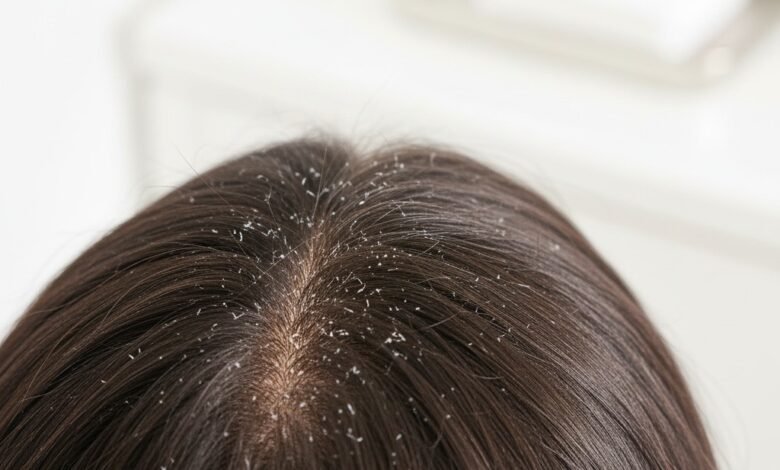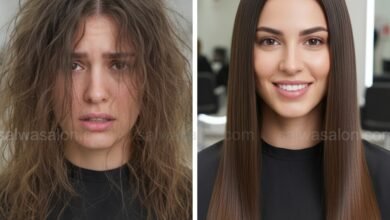Complete Guide to Overcoming Dry Dandruff: Effective Strategies from SalwaSalon.com

At SalwaSalon.com, we understand that scalp problems are often more complex than just a general label. The term ‘dandruff’ is often used collectively to describe flaking scalp conditions, whereas in reality, there are different nuances and types, each with specific triggers and treatments. As beauty content strategists and educators, we are committed to equipping you with in-depth knowledge to identify and effectively address your beauty concerns.
One type of dandruff that is often misunderstood is dry dandruff. Contrary to common myths, dandruff is not exclusive to oily scalps. In fact, dry and sensitive scalps are fertile ground for the appearance of these troublesome white flakes. This in-depth educational article will thoroughly explore the ins and outs of dry dandruff, from its definition, characteristics, fundamental causes, to scientifically-based treatment strategies you can implement.
Understanding Dry Dandruff: What It Is and Why It’s Different?
Dry dandruff is characterized by the appearance of dry, whitish-grey flakes or scales that easily fall off the scalp and hair. This symptom is often accompanied by itching, irritation, and even redness in the affected areas of the scalp. Fundamentally, dry dandruff is a manifestation of insufficient hydration and a compromised scalp barrier function.
Comparison of Dry Dandruff and Oily Dandruff (Seborrheic Dermatitis)
To comprehensively understand dry dandruff, it is important for you to know its fundamental differences from oily dandruff, or what is medically known as seborrheic dermatitis:
- Primary Origin:
- Dry Dandruff: Generally caused by a dry scalp, lack of moisture, and a compromised barrier function. This condition accelerates scalp cell turnover but with dry cell quality, leading to fine, easily detached flakes.
- Oily Dandruff (Seborrheic Dermatitis): Triggered by excessive sebum production by the sebaceous glands and overactivity of the Malassezia yeast (previously known as Pityrosporum ovale) which naturally exists on the scalp. This yeast digests triglycerides in sebum, producing irritating fatty acids, causing inflammation, redness, and stickier, oilier yellowish flakes.
- Flake Characteristics:
- Dry Dandruff: Flakes are generally smaller, finer, whitish or greyish, and easily fall off hair and clothing.
- Oily Dandruff: Flakes tend to be larger, oily, yellowish, and sticky, often clinging to the scalp or hair.
- Scalp Condition:
- Dry Dandruff: The scalp feels tight, dry, and can even appear dull and less elastic. Itching often occurs after shampooing due to moisture evaporation.
- Oily Dandruff: The scalp feels oily, sometimes sticky, and may appear reddish or inflamed.
If not treated properly, dry dandruff can trigger a damaging itch-scratch cycle. The habit of scratching the scalp, especially with fingernails, can cause micro-lesions, further inflammation, and weakening of hair follicles, which can ultimately contribute to hair loss.
Identifying the Characteristics of Dry Dandruff
To help you make an initial diagnosis, here are the specific characteristics of dry dandruff you should look for:
- The dandruff flakes are finer, smaller, and whitish-grey.
- The scalp feels tight, dry, and often shows signs of dehydration.
- Fine scales or mild flaking are visible on the scalp.
- Areas of redness or irritation appear on some parts of the scalp.
- Persistent itching, even after shampooing or when hair has just dried.
Trigger Factors for Dry Dandruff: An In-Depth Analysis
Dry dandruff is not caused by a single factor, but rather a complex interaction of various triggers, both internal and external. A comprehensive understanding of these causes is key to effective treatment.
- Scalp and Body Dehydration
This is a fundamental trigger. A scalp lacking hydration, whether due to inadequate systemic fluid intake (systemic dehydration) or external factors, will lose its elasticity and tend to flake. Your body needs sufficient water to maintain optimal cell function and skin barrier. When water intake is insufficient, the body prioritizes vital organs, reducing water supply to less vital areas such as the scalp. - Compromised Scalp Barrier Function
A healthy scalp barrier protects against external aggressors and prevents excessive water loss. When this barrier is compromised (e.g., due to harsh product use, frequent chemical exposure, or extreme environmental conditions), the scalp becomes vulnerable to dryness, irritation, and inflammation leading to flaking. - Environmental and Climatic Factors
Exposure to dry air, whether from cold climates, indoor heating, or air conditioning, can evaporate natural moisture from the scalp, exacerbating dry conditions. Drastic weather changes can also affect the scalp’s hydration balance. - Inappropriate Hair Care Product Use
Shampoos with harsh detergents (such as excessive sulfates), alcohol-based styling products, or aggressive hair dyes can strip the scalp’s natural oils (sebum) and disrupt pH, triggering dryness and irritation. - Incorrect Shampooing and Drying Habits
Washing hair with excessively hot water, shampooing too frequently with unsuitable products, or excessive use of high-temperature hair dryers can accelerate moisture evaporation and damage the scalp barrier. - Stress and Lifestyle
Chronic stress can disrupt the body’s hormonal balance, including the adrenal glands which affect skin health. Although sebaceous glands are more often associated with oily dandruff, stress can trigger inflammatory responses throughout the body, including the scalp, worsening dry and sensitive conditions. Lack of sleep also inhibits cell regeneration processes in the body, including the scalp. - Nutritional Factors
Deficiencies in certain nutrients, such as Zinc, Omega-3, or B-complex Vitamins, which play crucial roles in skin and hair health, can contribute to a dry scalp and susceptibility to dandruff. - Other Skin Conditions and Malassezia Yeast Reaction (Secondary Exacerbation)
Although Malassezia yeast is more dominant in oily dandruff, in cases of dry dandruff with a compromised barrier or inflammation, the activity of this yeast can become a secondary exacerbating factor. Furthermore, other skin conditions like eczema or psoriasis can also present symptoms similar to dry dandruff.
Comprehensive Strategies to Overcome Dry Dandruff
A holistic and sustained approach is key to effectively treating dry dandruff and restoring your scalp’s health.
- Implement a Proper Shampooing Routine
- Choose a Moisturizing Shampoo: Use shampoos specifically for dry and sensitive scalps. Look for formulations that are free from harsh sulfates and contain moisturizing ingredients like hyaluronic acid, glycerin, panthenol, or natural oils (argan, jojoba). For dry dandruff cases accompanied by Malassezia yeast as an exacerbating factor, anti-dandruff shampoos containing Pyrithione Zinc or Ketoconazole can be used, but ensure the formula also includes moisturizers to prevent worsening dryness.
- Optimal Water Temperature: Wash your hair with lukewarm water, avoiding hot water which can dissolve the scalp’s natural lipid layer and accelerate moisture evaporation.
- Gentle Massage Technique: When applying shampoo, gently massage the scalp with your fingertips (not nails) to cleanse effectively without irritation. This massage also improves blood circulation.
- Thorough Rinsing: Ensure no shampoo or conditioner residue is left on the scalp, as residue can cause irritation.
- Optimize Hair Drying and Avoid Excessive Heat
Minimizing heat exposure is crucial. If you use a hairdryer, always use the lowest heat setting or cool air mode. Keep the hairdryer about 15-20 cm away from the scalp and move it constantly to avoid concentrating heat. Ideally, let your hair air dry as much as possible or use a microfiber towel to gently absorb excess water. - Internal Nutrition and Hydration
- Adequate Water Intake: Ensure you consume at least 2 liters of plain water daily to maintain overall scalp and body hydration.
- Nutritional Supplements: Consider Zinc supplements, which play a vital role in cell regeneration and immune function. Omega-3s (found in salmon, flax seeds) and B-complex Vitamins are also essential for scalp and hair health. Consult a healthcare professional before starting any supplements.
- Balanced Diet: Enrich your diet with fruits, vegetables, whole grains, and lean proteins rich in antioxidants and essential nutrients.
- Use Additional Scalp Treatments
- Scalp Serum/Tonic: Choose a specialized scalp serum or tonic containing moisturizing ingredients (hyaluronic acid, aloe vera), anti-inflammatory ingredients (chamomile, centella asiatica), or soothing ingredients (allantoin). Regular application can help restore the scalp’s moisture balance.
- Hair Mask/Scalp Mask: Once a week, use a hair mask that can also be applied to the scalp to provide intensive hydration and nourishment.
- Manage Stress and Prioritize Rest
Given the role of stress in triggering inflammation, it’s crucial to manage your stress levels. Practice relaxation techniques such as meditation, yoga, or dedicate time to enjoyable hobbies. Ensure you get 7-8 hours of quality sleep each night to support optimal cell regeneration processes in the body.
Towards a Healthy Scalp with SalwaSalon.com
Tackling dry dandruff requires a deep understanding and commitment to proper care. It’s not merely an aesthetic issue but an indication of an imbalance in your scalp’s health. By implementing the comprehensive strategies we have outlined, from product selection and shampooing techniques to a healthy lifestyle, you can significantly improve your scalp condition and be free from bothersome dry dandruff.
SalwaSalon.com serves as your partner on the journey towards holistic and knowledge-based beauty. We are always ready to guide you with accurate information and effective solutions. Remember, a healthy scalp is the foundation for beautiful and strong hair. Feel free to explore our other educational resources or consult our experts if your condition does not improve.






